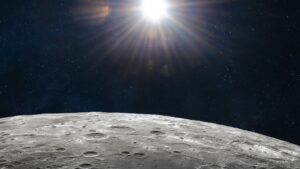It’s been years since I watched Christopher Nolan’s cosmic journey Interstellar, and the film’s fuzzy physics narrative now blurs together in my memory. But one epic image has stayed with me: a 4,000-foot tidal wave on an alien planet.
The tsunami nearly kills the film’s protagonists, but I could still imagine surfers staring at a wave bigger than El Capitan and thinking: “Looks like fun!”
So perhaps it’s no surprise that I feel the same way about mountaineering possibilities on distant planets. Thanks to camera-carrying spacecraft and Earth-orbiting telescopes, we have advanced imagery of the geography of celestial bodies throughout our solar system.
And some of those planets have features that beggar the imagination — then spark it to life again with a simple question: What would it be like to climb our way across the galaxy?

An image of the solar system’s biggest cliff — on Uranus’ icy moon Miranda. Photo: NASA
Miranda’s Verona Rupes
The tallest known cliff in the galaxy currently towers over the landscape of Miranda, a small moon orbiting Uranus.
Its most prominent feature is Verona Rupes, a titanic rock formation captured on camera by the Voyager 2 spacecraft back in 1986. Scientists have estimated its size at 20 kilometers tall — 10 times the depth of the Grand Canyon and nearly 17 times the height of Canada’s 1,200m Mount Thor.
Sound like an impossible climb? Maybe.
You’d certainly need next-level winter gear that could withstand daytime temperatures down to -170˚C. Solve that problem, and it might be possible to climb Verona Rupes.
That’s because the moon’s gravity is only 0.008 times as strong as Earth’s. According to NASA, if you fell from the top of Verona Rupes, it could take 12 minutes to hit the ground.
It would still be a long ascent, of course, but given the low gravity, who knows what’s possible?
Free solo expert Alex Honnold just climbed 7.3 kilometers at Red Rocks in a single outing — while dealing with Earth’s more lethal gravity — so I wouldn’t bet against him.
I’d pay to watch another Oscar-winning climbing documentary, this time titled: Alex Honnold: In Space!

This 3D image imagines what the terrain of Valles Marineris might look like up close. Illustration: Shutterstock
Mars’ Valles Marineris
Skyrunners like Kilian Jornet might actually break a sweat tackling the epic geography on Mars.
In addition to having the solar system’s biggest volcano, Olympus Mons, Mars also sports an incredible canyon named Valles Marineris. At 4,000km long, 200km wide, and 10 kilometers deep, its full size can only be viewed from space.
For comparison, the Grand Canyon is 446km long, 30km wide, and 1.6km deep. Hiking the length of Valles Marineris would offer quite the tour of the Red Planet, as it traverses about a fifth of its circumference.
It’s so wide that if you stood on one rim, you wouldn’t be able to see the opposite side — because it would hide beyond the horizon. The colossal valley was likely widened by massive floods three billion years ago, according to Space.com.
Like Miranda, Mars would offer a respite from Earth’s gravity, with just .375 times the force of Earth’s pull.
Is it a longer distance than the Grand Canyon? Absolutely. But crossing a massive canyon while making huge space jumps? It’s hard to picture a more epic expedition than that one.
Outdoor athletes around the world make a name for themselves by finding new places to explore. But that’s increasingly difficult on a planet with seven billion people.
To sate the human need for exploration, we may have to widen our search to the final frontier.
It’s easy to imagine that the world’s bravest adventurers will one day find themselves on another planet, staring up at a mountain 10 times the size of Everest — and start climbing.






